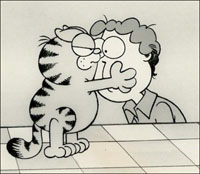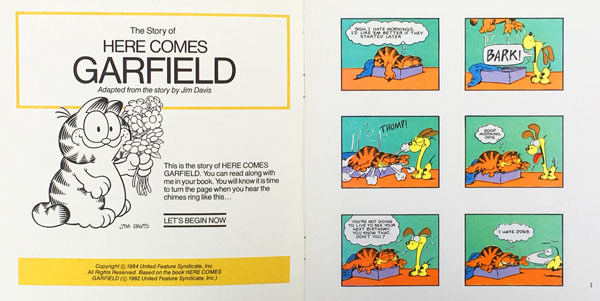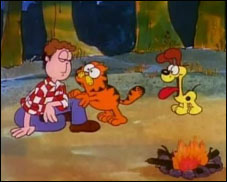When Disney’s Buena Vista Records produced the first three Garfield animated specials as read-along album sets, a unique approach was used for the adaptations.

The Story of
HERE COMES GARFIELD
Buena Vista Records #260
(7” 33 1/3 RPM with Book / Mono / 1984 / Also on Cassette)
Produced for Records by Bambi Moé. Based on the Comic Strip “Garfield” by Jim Davis. Writers: Jim Davis, Lorenzo Music. TV Executive Producer: Jay Poynor. TV Producers: Lee Mendelson, Bill Melendez. TV Director: Phil Roman. Music: Ed Bogas, Desirée Goyette. Running Time: 10 minutes.
Voices: Lorenzo Music (Garfield); Sandy Kenyon (Jon Arbuckle); Henry Corden (Hubert); Hal Smith (Reba, Skinny); Gregg Berger (Odie, Salesman); Angela Lee (Little Girl).
For over three decades, Garfield has been the star of numerous TV specials, two superb TV series, a feature film, advertising campaigns, car windows and office cubicles. There was a time, though, when the corpulent cat was the latest thing.
 Here Comes Garfield was eagerly awaited, as it not only was the first time Garfield, Jon and Odie came to animated life, it was also the work of Peanuts animation greats Lee Mendelson and Bill Melendez. It seemed as if it couldn’t miss—and fortunately, it didn’t. The special was a huge success, as was the soundtrack album featuring Lou Rawls and Desirée Goyette.
Here Comes Garfield was eagerly awaited, as it not only was the first time Garfield, Jon and Odie came to animated life, it was also the work of Peanuts animation greats Lee Mendelson and Bill Melendez. It seemed as if it couldn’t miss—and fortunately, it didn’t. The special was a huge success, as was the soundtrack album featuring Lou Rawls and Desirée Goyette.
For several years before Garfield’s CBS premiere, Disneyland/Vista Records had been expanding into non-Disney properties like Star Wars, Peanuts, Rankin/Bass, Little Golden Books and many others. Garfield was a hot property in the early ‘80s and Disney producer Bambi Moé adapted the first three Garfield specials as read-along book and record sets.
“A lot of effort went into making everything just right,” Moé recalled. “Even the cover art was especially done for the read-alongs.” What made them stand apart–even from Disney and Buena Vista’s other titles–was the special way each book was formatted. Rather than using either frame grabs from the films or single-image art for each page or spread, the stories are rendered as comic strips.

These comic strips never existed outside these three read-along sets. “We used the storyboards from the studio,” says Moé. “The art was adapted into comic strips with dialogue balloons to match the recording.” Some of the panels have no dialogue at all.
Except for announcer Chuck Riley’s introduction, there is no narration on the records. Sound and vocal effects are used for the non-dialogue sections.
This is a highly unique way to produce a read-along. Peter Pan Records had released a number of children’s stories and superhero adventures (even Bible stories) with a comic book-read along book, but there was still narration. In the late’40s/early’50s, Capitol occasionally produced an album in which numbered pictures had no text, but there was plenty of exposition on the record to cover the action. There may have been no other read-alongs quite like these Garfield sets.
Here Comes Garfield is also notable because of the presence of Henry Corden in the cast. The second voice of Fred Flintstone, as well as a familiar face on The Monkees, The Brady Bunch and countless film and TV shows, this is his sole Disney recording.

The Story of
GARFIELD ON THE TOWN
Buena Vista Records #261
(7” 33 1/3 RPM with Book / Mono / 1984 / Also on Cassette)
Produced for Records by Bambi Moé. Based on the Comic Strip “Garfield” by Jim Davis. Writer: Jim Davis. TV Executive Producer: Jay Poynor. TV Producers: Lee Mendelson, Bill Melendez. TV Director: Phil Roman. Music: Ed Bogas, Desirée Goyette. Running Time: 11 minutes.
Voices: Lorenzo Music (Garfield); Thom Huge (Jon Arbuckle); Gregg Berger (Odie; Ali Cat); George Wendt (Raoul); Sandi Huge (Garfield’s Mom); Julie Payne (Dr. Liz Wilson); C. Lindsay Workman (Garfield’s Grandfather); Allyce Beasley (Lady Cats); Desirée Goyette (Lady Cat).
Because Here Comes Garfield was the strip’s TV debut, it contained some classic moments and well-known Garfield quotes, such as “Show me a good mouser, and I’ll show you a cat with bad breath.” The mission accomplished, it was time to take the stories out into new territory.
Garfield on the Town doesn’t take place on Broadway as the title and the signature art suggests, but instead reunites the feline with his less-fortunate family. It also introduces Thom Huge as the voice of Jon, replacing Sandy Kenyon, who was also an Entertainment Tonight correspondent at the time.
Cheers star George Wendt makes his second Garfield cartoon voice appearance, this time as Raoul, a relative of Garfield. Julie Payne would go on to voice several characters in the acclaimed Garfield and Friends series, including Lanolin the sheep in the U.S. Acres segments.

The Story of
GARFIELD IN THE ROUGH
Buena Vista Records #262
(7” 33 1/3 RPM with Book / Mono / 1984 / Also on Cassette)
Produced for Records by Bambi Moé. Based on the Comic Strip “Garfield” by Jim Davis. Writer: Jim Davis. TV Producers: Jay Poynor, Phil Roman. TV Director: Phil Roman. Music: Ed Bogas, Desirée Goyette. Running Time: 13 minutes.
Voices: Lorenzo Music (Garfield); Thom Huge (Jon Arbuckle); Gregg Berger (Odie; Ranger); George Wendt (Ranger); Hal Smith (Ranger); Orson Bean (Bill Rabbit); Desirée Goyette (Lady Cats).
Garfield, Jon and Odie venture into the wilderness and encounter danger in the third special (all three have been released on DVD). This would be Orson Bean’s second Disneyland/Vista recording, as he voiced Bilbo Baggins in the Rankin/Bass Production of The Hobbit, a best-selling Grammy nominee for the label.
 The music for all three read-alongs is performed on solo piano, presumably by Ed Bogas, replacing the more orchestrated music in the specials. All the voices are the genuine actors and are not studio sound-alikes, which was not always standard practice for read-alongs. Perhaps Disneyland/Vista’s partnership with Lee Mendelson on the Peanuts records was part of the reason.
The music for all three read-alongs is performed on solo piano, presumably by Ed Bogas, replacing the more orchestrated music in the specials. All the voices are the genuine actors and are not studio sound-alikes, which was not always standard practice for read-alongs. Perhaps Disneyland/Vista’s partnership with Lee Mendelson on the Peanuts records was part of the reason.
The Garfield series was just a part of Bambi Moé’s creative influence on Disneyland/Vista Records, which included bringing artists such as Edwin Starr and Patty and Michael Silversher to the label, as well as numerous albums and read-alongs. Like writer/producer Jymn Magon, Moé migrated to Disney TV Animation after Gary Krisel (who had been president of the label), helped start the division. Among her credits were music production on A Goofy Movie and the series versions of The Little Mermaid and Aladdin.
GIVE A LITTLE LISTEN
Excerpt of “Here Comes Garfield” Read-Along
This short clip provides an idea of how the comic panel-style read along progressed. There was no narration and sometimes a dialogue-free frame. The reader’s eyes simply followed at the pace of the recording. Sometimes a panel might only require a split second glance.


 GREG EHRBAR is a freelance writer/producer for television, advertising, books, theme parks and stage. Greg has worked on content for such studios as Disney, Warner and Universal, with some of Hollywood’s biggest stars. His numerous books include Mouse Tracks: The Story of Walt Disney Records (with Tim Hollis). Visit
GREG EHRBAR is a freelance writer/producer for television, advertising, books, theme parks and stage. Greg has worked on content for such studios as Disney, Warner and Universal, with some of Hollywood’s biggest stars. His numerous books include Mouse Tracks: The Story of Walt Disney Records (with Tim Hollis). Visit 





















































Excellent post today, Greg!
“…as was the soundtrack album featuring Lou Rawls and Desirée Goyette.”
I’d love to learn more about this album (or others like it). The performances by Rawls (and sometimes featuring Goyette) were such an underrated part of what made all the Garfield specials so great!
I always wondered if Desiree Goyette was related to Mendelson or Melendez. Before she participated in the Garfield specials (and that lamentable “Romance of Betty Boop” thing), she was one of the correspondents on the short-lived revival of “You Asked For It,” also produced by M+M.
Tim Hollis and I did a section about Desirée in Mouse Tracks. She was married to Lee Mendelson for a time. Both extremely nice people.
Didn’t Desiree also worked on that one Hasbro show about rock music? I keep expecting Greg to talk about that, but I don’t think that there were any tie-in records for that show.
Garfield on the Town was actually somewhat based on a story-arc in the comic (it’s much more light-hearted, obviously). The special is probably the first and only time Lorenzo Music had a hand in writing anything Garfield-related (sorta like Billy West in the Games era of Ren and Stimpy, writing “Ol’ Blue Nose”)..
Re: your album excerpt above, the original line in the special as first broadcast (taken directly from the 5/6/79 comic strip) was, “I’m so happy to own a cat, I could just throw up.” The last part was excised from all future airings.
Someone got a little testy!
Top Cat James: Wow, are you sure about that cut scene in “Here Comes Garfield”?? I’ve never heard about that anywhere before… I just assumed that line was simply softened for the TV special, for the same reasons that made them change Garfield grabbing Jon’s neck in one panel to grabbing his cheeks in the animated version: https://garfield.com/comic/1979/05/06
@ Mesterius
Absolutely. It’s even in the companion paperback-
http://www.ebay.ca/itm/331778268848?rmvSB=true
Click on the 4th image.
Top Cat James: Well, yeah, it’s in the adapted paperback, but that doesn’t prove anything. There were *many* instances where the comic strip versions of the TV specials included sequences that were not in the animated versions. One example of this is a gift wrapping sequence with Garfield and Odie early on in “A Garfield Christmas Special”, which is included in the comic strip version but never seen in the animated special.
Have you ever actually watched the animated scene in “Here Comes Garfield” with the “…I could just throw up” line included?
Yes, the line was actually in the premiere, and, yes, I actually heard it, which is why i posted my original comment. And you can choose to believe it or not.
Those comic strip adaptations did exist outside of the read-along records…they were also available as 64-page paperbacks printed the same size as then-current Garfield comic strip reprint books, and later re-issued in the compilations Garfield as Himself, Garfield Holiday Celebrations and Garfield Travel Adventures to tie-in to the then-current DVD releases.
Thanks, Deb. Never knew that!
Most of the Garfield specials received paperback treatments of this sort.
ALL of the 12 prime-time animated Garfield specials received paperback treatment by Ballantine, in fact. And it felt quite obvious that the comic strip versions were based on the original storyboards (which were produced by Jim Davis and his team at Paws, Inc.), because they often included sequences which were not in the finished TV specials, likely cut for time. In some cases, sequences in the comic strip version also differed from how the same sequences played in the animated version; like the part of “A Garfield Christmas Special” where Garfield finds out that Odie is secretly making him a gift.
In some cases, sequences in the comic strip version also differed from how the same sequences played in the animated version; like the part of “A Garfield Christmas Special” where Garfield finds out that Odie is secretly making him a gift.
In much the same deal as Grandma Arbuckle’s piano solo that was seen in those books, but was not seen originally in the TV special when it first aired in ’87, but was added in during the early 90’s.
“These comic strips never existed outside these three read-along sets.”
Greg, if I’m not mistaken, they actually originated in Ballantine’s full-on comics adaptations of the specials. Here’s the one for Here Comes Garfield.
Wow. Thanks for the clarification! So the read along used them for the recording. It was an unusual way to do a Disney read-along, but the strips were part of the reason it was done.
Perhaps it made it easy on their part not to put too much effort in the pages if they already had something in development done by Jim’s crew or such.
I’d forgotten this, but it also turns out there was one animated Garfield appearance prior to these. In 1980, the “Fabulous Funnies” network special featured a few Garfield skits mixed in with other comic strip adaptations.
• Opening, with a brief Garfield scene: https://www.youtube.com/watch?v=qKq-UkXM190
• Later Garfield segment, beginning at 0:18: https://www.youtube.com/watch?v=0f5XunZB9bU
An earlier Cartoon Research feature covered this special: https://cartoonresearch.com/index.php/the-fantastic-funnies-1980/
By the way, Greg, “*a* feature film”? Don’t get me wrong — I hate “Garfield: A Tail of Two Kitties” as much as the next guy, but the fact remains that there have been TWOlive-action/CG theatrical Garfield films. 😉 Not to mention three all-animated direct-to-video features which came out in 2007, 2008 and 2009, all of them written by Jim Davis (and all of them making you long for the glory days of Davis’ 80s prime-time specials).
I’m sure they do. Garfield wasn’t quite the overused feline the way he was used in those original specials.
“The special was a huge success, as was the soundtrack album featuring Lou Rawls and Desirée Goyette.”
One thing I’m wondering about here: if the soundtrack album for “Here Comes Garfield” was such a huge success (I’m assuming you mean commercially), then why didn’t the following 11 Garfield specials get any soundtrack albums?
That is an interesting one, unless there were plans to do so in place but they simply ditched it at the last minute. I know there was a later Garfield CD that came out with a few songs heard in the final special “Garfield Gets A Life”.
Actually, it was the other way around: the comic strip did its own version of Garfield meeting his mother a whole year after the animated special, for the Christmas of 1984. So this is an example of how the TV specials affected the strip. Clearly Jim Davis wanted to establish Garfield’s mom in the regular comic strip as well.